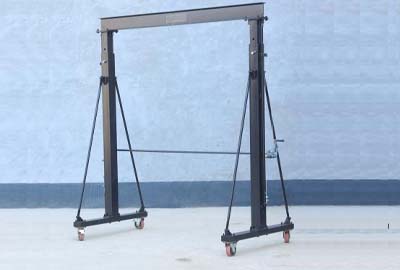Lightweight Gantry Crane for Efficient Handling and Versatile Applications in Various Settings
Light Duty Gantry Crane A Comprehensive Overview
In the world of material handling and industrial operations, the efficient and safe movement of goods is paramount. One key tool used to improve productivity in various sectors is the light duty gantry crane. This versatile piece of equipment is designed to lift and transport lightweight loads, making it an essential asset for small manufacturing companies, workshops, and construction sites.
What is a Light Duty Gantry Crane?
A light duty gantry crane is a type of crane characterized by its overhead structure, which consists of a supporting framework that spans an area to allow vertical lifting. Unlike heavy-duty cranes, which can lift thousands of tons, light duty gantry cranes are typically designed to handle loads ranging from a few hundred kilograms up to about 5 tons. They are often constructed from materials such as steel or aluminum, ensuring both strength and portability.
These cranes feature a bridge that moves along horizontal tracks, which can be either floor-mounted or elevated, enabling precise movement of materials across a designated area. The lifting mechanism usually includes a hoist that may be operated manually or powered, offering flexibility in operation.
Applications of Light Duty Gantry Cranes
Light duty gantry cranes find applications in various industries due to their adaptable nature. Some common uses include
1. Manufacturing In factories, these cranes are employed to lift components and raw materials, streamlining production processes. They help in moving items between stations without the need for labor-intensive manual handling.
2. Construction Light duty gantry cranes are invaluable on construction sites for lifting lightweight construction materials, tools, and equipment, thus enhancing worker safety and efficiency.
3. Warehousing In warehouses, gantry cranes facilitate the organization of items by securely lifting and transferring goods to and from storage areas, ultimately improving logistics.
4. Maintenance and Repairs They are often used in automotive shops and equipment maintenance facilities, allowing technicians to lift engines and other heavy parts for repair or replacement.
5. Research and Laboratories Light duty gantry cranes are utilized in laboratories for moving delicate instruments or samples, ensuring safety and preventing damage.
Benefits of Light Duty Gantry Cranes
The adoption of light duty gantry cranes in various settings offers numerous benefits
light duty gantry crane

- Cost-Effectiveness Compared to larger, heavy-duty cranes, light duty gantry cranes are generally more affordable both in terms of initial investment and maintenance costs.
- Portability Many light duty models are designed to be mobile, allowing for quick relocation to where they are needed most. Some come with wheels or can be disassembled for easier transport.
- Space Efficiency Light duty gantry cranes occupy minimal space, which is essential in compact work environments where every square foot counts.
- Ease of Use Designed for straightforward operation, these cranes can often be used by personnel with minimal training, thereby reducing downtime and improving efficiency.
- Safety Features Modern light duty gantry cranes come equipped with various safety features such as overload protection, limit switches, and emergency stop buttons to ensure safe operation.
Considerations When Choosing a Light Duty Gantry Crane
When selecting a light duty gantry crane, several factors must be considered to ensure the right fit for the specific application
1. Load Capacity Determine the maximum weight that will be lifted to select a crane with appropriate capacity.
2. Span and Height Assess the area where the crane will be used. This includes understanding the required height and span to cover the desired operational area.
3. Mobility Needs Consider whether the crane will need to be moved frequently or if it will remain stationary for specific tasks.
4. Construction Material Choose the material based on the environment; for instance, aluminum cranes are lighter and more portable, while steel cranes offer greater strength.
5. Budget Factor in not just the initial purchase cost but also ongoing maintenance and operational expenses.
Conclusion
Light duty gantry cranes play a pivotal role in enhancing productivity and operational efficiency in various industries. Their versatility, cost-effectiveness, and ease of use make them an essential tool for businesses looking to improve their material handling processes. As industries continue to evolve, these cranes will undoubtedly remain integral to the safe and efficient movement of goods and materials, paving the way for innovation and growth in the field of industrial operations.
-
Portable 2000 lb Gantry Crane | Heavy-Duty & AdjustableNewsAug.30,2025
-
Versatile Lifting Solutions with Gantry and Overhead CranesNewsAug.29,2025
-
The Versatile Mobile Gantry Crane SolutionNewsAug.29,2025
-
Reliable Movement with Heavy Machinery Skates and RollersNewsAug.29,2025
-
Reliable Lifting Performance with 2000 lb Gantry Crane and 2 Ton Overhead SystemsNewsAug.29,2025
-
Maximize Lifting Efficiency with PML Magnetic LiftersNewsAug.29,2025
-
Efficient Relocation Starts with Reliable Machinery MoversNewsAug.29,2025
